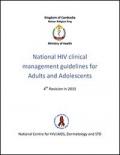Guidelines - Released in 2015
This HIV clinical management guideline is substantially changed from the 2012 guidelines.
This is a consolidated guideline, including sections on antiretroviral therapy and opportunistic infections, which were previously contained in two separate documents. In addition to avoiding repetition, the intention is also to make the format more concise, with more dot points, tables and algorithms than paragraphed text.
The changing clinical needs of PLHIV necessitate a broadening of the scope of the guideline. As more PLHIV are now established on combination antiretroviral therapy they will experience less late stage complications of advanced immunodeficiency. HIV itself, and longterm combination antiretroviral therapy (ART), increases the risks and complications associated with metabolic and non –communicable (NCD) diseases as people age. This guideline includes a new section on non-communicable diseases to guide the clinician to advise patients regarding the prevention of NCD, to incorporate screening for NCD into routine consultations, and for the investigation and management of NCD. The clinician is directed to Cambodian National NCD guidelines for management of hypertension and diabetes. Whilst the HIV clinician may not always lead the management of NCD if the patient has the opportunity to attend a specialised clinic, the HIV clinician must have a good understanding of these common conditions, and in particular drug interactions with ARV.
Downloads
Organizations
- National Center for HIV/AIDS, Dermatology and STD (NCHADS) - Cambodia






